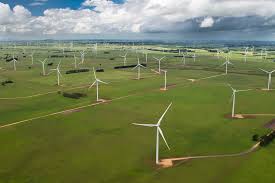The Macarthur wind farm in Victoria– at 420MW – is Australia’s biggest. But in the last 12 months it has been the worst performing of any wind farm in the state, and among the worst in the country.
When it was first announced way back in 2010, it was tipped to deliver a capacity factor of around 35 per cent. It opened in early 2013, but in 2016/17, it delivered a capacity factor of just 23 per cent.
“The performance of the Macarthur wind farm in FY2017 was primarily affected by planned outages and poor wind conditions,” an AGL spokesperson said in an emailed response to enquiries by RenewEconomy.
True enough, there were shutdowns of around 3 weeks that may have explained some of the lost output, and wind farms across Victoria and South Australia were all affected by weaker than normal wind conditions in the last quarter.
But that doesn’t appear to resolve the difference between Macarthur and other wind farms in the state. Nor does it explain its poor showing the previous year (26 per cent) when there were no apparent interruptions.
The performance of Macarthur has been the subject of much speculation in the wind industry, with no one too sure what is the reason for the lower than expected performance.
 Indeed, according to this data from the Climate and Energy College, it has never produced anywhere near its hoped-for capacity, and never reached above 28.6 per cent.
Indeed, according to this data from the Climate and Energy College, it has never produced anywhere near its hoped-for capacity, and never reached above 28.6 per cent.
By contrast to Macarthur’s output, Stockyard Hill, which at 530MW will dislodge Macarthur as the biggest wind farm in the country, is expected to have a capacity factor of around 45 per cent. Little wonder, then, that it is able to deliver electricity to its client Origin Energy at less than $55/MWh (free of subsidies).
Hornsdale in South Australia, the next biggest at 309MW, is expected to also have a capacity factor in the 40s when its third stage is finished in the next few months. Snowtown has performed as high, reaching 44 per cent in 2014/15.
The 207MW Collgar wind farm in Merredin in Western Australia, is also a strong performer with capacity factors in the mid to high 40s.
Of AGL’s new wind farms, the 200MW Silverton wind farm near Broken Hill is expected to have a capacity factor of around 44.5 per cent, while the 460MW Cooper’s Gap in Queensland is expected to have a capacity factor of around 35 per cent.
To put Macarthur’s recent performance in context, here is a list of the capacity factors of all the wind farms in South Australia over the last five years, from last year’s AEMO analysis of renewable energy in that state.
 It shows that no wind farm in South Australia had a capacity factor a low as 23 per cent in the five years surveyed by the market operator.
It shows that no wind farm in South Australia had a capacity factor a low as 23 per cent in the five years surveyed by the market operator.
Of course, wind farms are not the only energy source to either not perform to expectations, have low availability, or not get used at all.
AGL’s Liddell coal plant operated at a capacity factor of just 51 per cent last year, despite increasing its “availability” from just half the time when it had to shut down for repairs to just over three-quarters of the time. The Torrens gas plant was not available nearly one-quarter of the time.
The Somerton peaking plant was used just 2 per cent of the time. But at least it was switched on. The Merredin peaking plant in WA still has not been switched on, despite being paid for by consumer subsidies.











